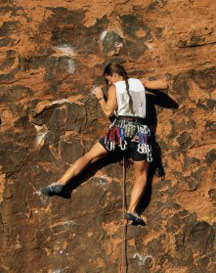“The harder you fall, the heavier your heart; the heavier your heart, the stronger you climb; the stronger you climb, the higher your pedestal.” Criss Jami
http://www.goodreads.com/quotes/tag/climbing
 http://www.blackhillsbadlands.com/home/things-to-do/outdoor-recreation/summer/rockclimbing
http://www.blackhillsbadlands.com/home/things-to-do/outdoor-recreation/summer/rockclimbingI thought i'd begin this post with a quote. Climbing is all about pushing yourself up. During this process though you will fall. If you can cling back to the wall and continue upwards, you will have great success in climbing. Your pedestal (potential) will be raised and you can do bigger and better things.

http://isucceedbook.com/success-stories/success-story-a-friend-of-the-family/attachment/mountain-climbing-2/
There are three main types of climbing that I will discuss in this post. The first being top rope, the second being lead, and the third being boldering.
Top Rope: Top rope climbing is among the most popular type of climbing especially among beginners. Hence its name, the rope is freely fixed to the top of the wall and the climber climbs towards the top where the rope is fixed. The belay in a sense is pulling the rope up toward the top of the wall as the climber continues upward. If the climber falls they do not fall far at all as long as the belayer locks off quickly on the rope. Another plus for beginners who might be afraid of heights.

http://www.rogerwendell.com/climbingphotos.html
LEAD: Lead climbing is what most professional or advanced climbers do. On big walls outside, lead climbing is also heavily used. Unlike top rope in lead climbing the rope is underneath the climber. As the climber ascends they clip into quickdraws along the route. these quickdraws are what catch the climbers if they fall. Being that a quickdraw is only one carabiner and the climber is climbing above the quickdraw a fall during lead climbing is much more dramatic than a fall in top roping. The climber falls to the last quickdraw they clipped into and then even farther below that. The epitome for most climbers and for major big wall stuff, lead climbing is the way to go.

 http://www.meetup.com/climbing/events/98701002/
http://www.meetup.com/climbing/events/98701002/http://www.climbingtechniques.org/sport-leading-basics.html
Bouldering: My favorite!:) Bouldering is one of the freest forms of climbing (literally, beside free soloing). No ropes, no harness. Just shoes, chalk, a brush and yourself. Bouldering is done with crash mats below you to cushion a fall. Most routes, or 'problems' as they are called, typically do not exceed 15ft. Many bouldering problems work under overhangs and require skillful movements to make them happen, or to 'solve' them. Some bouldering routes require a 'dyno' move. A dyno is when one must simply jump having all points of contact removed from the wall in order to catch the next piece of rock. Bouldering can be great fun and alos very challenging. Again, if you are going to attempt bouldering in your backyard you must have two things. One, a crash pad, two, a spotter. A spotter can protect the head from hitting the crash pad. Its great fun! Most climbing gyms will have a section of the gym that is dedicated to just bouldering.


http://www.dpmclimbing.com/climbing-gear/view/new-guidebook-j-tree-bouldering
No comments:
Post a Comment